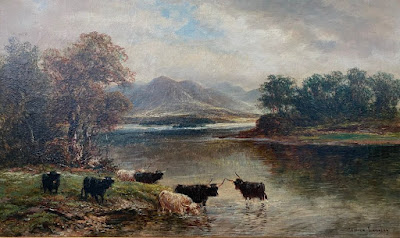 |
| A painting by George Ames Aldrich |
There are two things I've always enjoyed doing, painting, and writing stories. I've done both of those activities off and on for most of my life. I have a closet full of paintings, at least 1500 of them of various sizes and styles, that are worth millions of dollars, if my kids play their cards right once I'm dead. (See Upton Sinclair's Lanny Budd books.) Alas, over the last five years my output of paintings as diminished to the point were I was only painting covers for my books, and that only begrudgingly, and not very well, either. With my story writing seemingly winding down, I'd like to get back into painting, and to that end, I've been surveying the world of art to get that set of creative juices flowing once again.
That survey of art has taken the form of watching slide shows of paintings from the vast collection of the Learn from Masters video collection of paintings. It includes work from over 800 painters, some of which are represented by only several dozen paintings, while others have hundreds or more. Each painting is shown for something like 6 or 7 seconds, though you can pause the video if you care to to study a painting longer. I, on the other hand, am only trying to get an overview, a feel for art again, and perhaps absorb in some intuitive manner what works and what doesn't, so I play the videos at 2X speed, viewing each painting for only 2 to 3 seconds. Some painting deserve a lot more time and attention, and others, less, I'm not trying to study art, but experience it. So far I've viewed 35,301 paintings from a mere 260 different artists.
Ideally, the paintings would be arranged chronologically so that you could see the evolution of the artist. But given the sheer number of paintings this person has assembled, I'll not complain that they are in rather random order. It would be nice if they were titled, but again, given the sheer numbers... The other problem inherent in the presentation is that all the paintings are more or less the same size. A painting could be 7 inches wide or 7 foot wide and both would appear to be the same size on the screen. This is unavoidable. However, since both finished paintings and small field studies are presented in more or less the same size, it is sometime difficult to know what the artist intended the painting to be. Was the artist painting in an impressionist style, or are we're seeing just the preliminary plein air painting made on the scene for use as a reference in producing a finished work completed in the studio. Below is an example of what I believe is a study:
And here is the finished work:
 |
| Both painting by Maximilien Luce |
Sometimes the paintings are clearly quick studies for a larger work, but sometimes they stand on their own as a completed painting. In the case above what appears to be the study was shown in the presentation after the finished one, but close enough in the series that I recognized it as more or less the same painting I'd seen earlier. When you can see both the study and the finished product, you can see how a painting is developed.
I have a number or art books on impressionist painters, so every now and again I'll come across a painting from a less famous artist that I recognize. Plus it is nice to see more than one example of their work to judge them by.
I am a landscape/cityscape/seascape sort of person, so those are generally my favorites, but I do enjoy seeing portraits as well, especially when well executed. and there are plenty of them in many collections. And because these paintings can date back something like 200 years, they offer the viewer an authentic glimpse of the life of the people of bygone eras, as well as taking the viewer to exotic locales, some real, other imagined.
Here are some other things I've learned so far.
There are a lot of paintings and a lot of artists. With 800+ artists, there could be a 100,000 paintings to view.
 |
| Kylie Cows Watering by William Langley |
Cows are aquatic animals. Many of the old landscapes that have lakes also have cows knee deep in them. Who knew?
 |
| Watercolor by William Russell Flint |
It seems that it was common for young women to gather and skinny-dip. Or so a lot of painters would have us believe. I suspect this was either wishful thinking or a fringe benefit of being an artist. What a racket.
 |
| Grand Canal Venice by Thomas Moran |
 |
| Docks of Paris Les Quais by Eugene Galien-Laloue |
And Paris.
 |
| London by Giuseppe de Nittis |
 |
| Robert Lewis Stevenson by John Singer Sargent |
Many, if not most artists, painted portraits. I suspect because those commissions paid the bills.
 |
| Benefits Supervisor Sleeping by Lucian Freud |
Many, if not most artists, painted nudes. It was considered classic "art." Right. As I said, quite a racket.
There are, indeed, such things as masterpieces. Many times when going through a collection I will come across one or two paintings that just seem to stand out from all the rest - a combination of the right scene, lighting, colors, and execution. They are, however, rare, which is what makes them masterpieces.
I should've been taking notes, but I didn't, and now it's too late now.
Some people keep track of how many states they visit, or foreign countries. I'm going for how many paintings and drawing I've viewed.
In addition to these paintings, I'm currently up to date on installment no. 98 of Pete Beard's survey of forgotten illustrators that you can find here. In each of these segments he highlights the work of 4 illustrators in each 15 minute or so installment. I haven't counted how many pieces he shows, as it varies according to the amount of source material he has to work with, but between them and the special shows of a single artist or style, they could easily add another 5,000 paintings and drawings to my total.
Illustration for books and posters is another facet of art which I find fascinating. In many cases, I really like the illustrator's approach to a subject, though I like some countries' illustrators more than others. As I said, all fascinating stuff.
 |
| Stanley R Badmin advertising art |
We'll have to see if it pays off.



HI
ReplyDeleteHelen's mom is a painter. Her backlist is a quonset hut and her plan much like yours. Since my wife is one of the kids I am interested to see how it plays out.
https://forestraven.tripod.com/oldwebsite/
Helen and I love art and galleries etc. We have also been watching the Peter Beard series, boy he has put a lot of work into those. It is amazing how many lovely posters they produced for the London underground over the years.
All the best
Guy
Thanks for your comment, Guy. The business plan of every artist must take into account that their work isn't going to be fully valued until they are dead. It's a basic econ 101 supply and demand issue. So it is always going to be up to the heir to maximize their art, or at least get it out into the world somehow. In that Lanny Budd series of books, Lanny slowly releases the paintings of his deceased stepfather to build up a demand for them. You need a dealer or famous person to promote your work.
DeleteThe Learn from Masters series is likely far from an exhaustive survey of a lot of these artist, but it sure beats a sample or two in some art book.
The Pete Beard series is wonderful. And while I certainly don't like a fair amount of the art shown, (i.e. German to name one country) what I do like, I really like. It is interesting, given all the hub-bub about AI taking over the arts to see how photography replaced illustrators 80 years ago. Some illustrators built mansions from their work, and within a decade or two, their market was gone.